
The Araneomorphae are an infraorder of spiders. They are distinguishable by chelicerae (fangs) that point diagonally forward and cross in a pinching action, in contrast to the Mygalomorphae, where they point straight down. Araneomorphs comprise the vast majority of living spiders.

The Pholcidae are a family of araneomorph spiders. The family contains over 1,800 individual species of pholcids, including those commonly known as cellar spider, daddy long-legs spider, carpenter spider, daddy long-legger, vibrating spider, gyrating spider, long daddy, and skull spider. The family, first described by Carl Ludwig Koch in 1850, is divided into 94 genera.
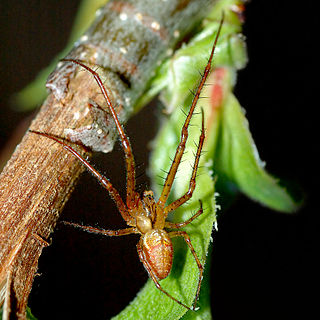
Long-jawed orb weavers or long jawed spiders (Tetragnathidae) are a family of araneomorph spiders first described by Anton Menge in 1866. They have elongated bodies, legs, and chelicerae, and build small orb webs with an open hub with few, wide-set radii and spirals with no signal line or retreat. Some species are often found in long vegetation near water.

Metellina mengei is a spider of the family Tetragnathidae that is found in Europe up to Georgia. It was once considered a form of M. segmentata that occurs in spring. M. mengei is much rarer than M. segmentata.
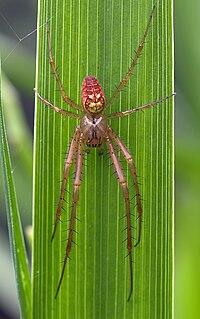
Metellina segmentata is a spider in the family Tetragnathidae with a Palaearctic distribution. This spiders name is often shortened to Meta segmentata, and some even call it Araneus segmentatus simply meaning, orb weaving spiders. It is primarily found in Europe, with the highest number in the United Kingdom, but the species has also been introduced to Canada.

Alireza Zamani is an Iranian arachnologist and taxonomist.
Mollemeta is a monotypic genus of long-jawed orb-weavers endemic to Chile. It contains the single species, Mollemeta edwardsi, first described as Landana edwardsi, based on a female found in 1904. The name is a reference to "Molle", the Mapudungun word for "tree", because it builds its vertical orb webs on tree trunks. It is in a clade with Allende, Chrysometa, Dolichognatha, Meta, and Metellina due to several autapomorphies, including the unique shapes of the cymbium, conductor, and embolus.
Titiotus flavescens is a species of false wolf spiders & wandering spiders in the family Zoropsidae. It is found in the United States.
Clubiona kastoni, the kaston sac spider, is a species of sac spider in the family Clubionidae. It is found in the United States and Canada.
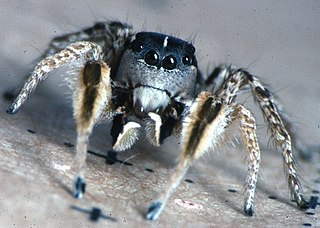
Habronattus tarsalis is a species of jumping spider in the family Salticidae. It is found in the United States and has been introduced into Hawaii.

Habronattus conjunctus is a species of jumping spider in the family Salticidae. It is found in the United States and Mexico.
Diguetia albolineata is a species of desertshrub spider in the family Diguetidae. It is found in the United States and Mexico.

Acanthepeira stellata, known generally as the starbellied orbweaver or starbellied spider, is a species of orb weaver in the spider family Araneidae. It is found in a range from Canada to Mexico. It is most commonly found along the Eastern and Western coastline of North America.
Herpyllus cockerelli is a species of ground spider in the family Gnaphosidae. It is found in the United States and Mexico.

Philodromus marxi, the metallic crab spider, is a species of running crab spider in the family Philodromidae. It is found in the United States. They are a sexually dimorphic species. The males are smooth with a metallic sheen and the females present as bristly white and grey.
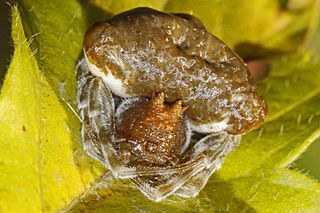
Mastophora phrynosoma is a species of orb weaver in the spider family Araneidae. It is found in the United States. Like all known species of the genus Mastophora, adult females are bolas spiders, capturing their prey with one or more sticky drops at the end of a single line of silk rather than in a web. Males and juvenile females capture their prey directly with their legs.

Scytodes fusca, the brown spitting spider, is a species of spitting spider in the family Scytodidae. It is found in Central and Southern America, has been introduced into Europe, tropical Africa, Seychelles, Myanmar, China, Japan, and Hawaii.
Phidippus comatus is a species of jumping spider in the family Salticidae. It is found in North America.
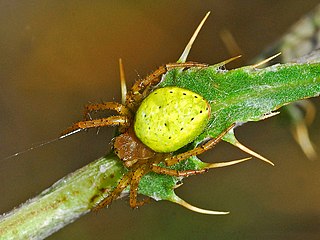
Araniella opisthographa is a species of orb weaver in the spider family Araneidae.

Father Chrysanthus O.F.M. Cap., born Wilhelmus Egbertus Antonius Janssen, was a Dutch priest and biology teacher. He was known for his studies in arachnology. Initially he was concerned with the spiders of the Netherlands but he became a specialist on New Guinea spiders. Two spider species were named in his honor following his death.













